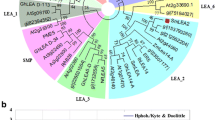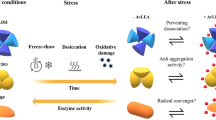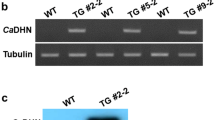Abstract
Late embryogenesis abundant (LEA) proteins constitute a large protein family that is closely associated with resistance to abiotic stresses in multiple organisms and protect cells against drought and other stresses. Azotobacter vinelandii is a soil bacterium that forms desiccation-resistant cysts. This bacterium possesses two genes, here named lea1 and lea2, coding for avLEA1 and avLEA2 proteins, both containing 20-mer motifs characteristic of eukaryotic plant LEA proteins. In this study, we found that disruption of the lea1 gene caused a loss of the cysts’ viability after 3 months of desiccation, whereas at 6 months, wild-type or lea2 mutant strain cysts remained viable. Vegetative cells of the lea1 mutant were more sensitive to osmotic stress; cysts developed by this mutant were also more sensitive to high temperatures than cysts or vegetative cells of the wild type or of the lea2 mutant. Expression of lea1 was induced several fold during encystment. In addition, the protective effects of these proteins were assessed in Escherichia coli cells. We found that E. coli cells overexpressing avLEA1 were more tolerant to salt stress than control cells; finally, in vitro analysis showed that avLEA1 protein was able to prevent the freeze thaw-induced inactivation of lactate dehydrogenase. In conclusion, avLEA1 is essential for the survival of A. vinelandii in dry conditions and for protection against hyper-osmolarity, two major stress factors that bacteria must cope with for survival in the environment. This is the first report on the role of bacterial LEA proteins on the resistance of cysts to desiccation.







Similar content being viewed by others
References
Alexeyev MF, Shokolenko IN, Croughan TP (1995) Improved antibiotic-resistance gene cassettes and omega elements for Escherichia coli vector construction and in vitro deletion/insertion mutagenesis. Gene 160(1):63–67
Baker J, Van DennSteele C, Dure L 3rd (1988) Sequence and characterization of 6 LEA proteins and their genes from cotton. Plant Mol Biol 11(3):277–291
Bali A, Blanco G, Hill S, Kennedy C (1992) Excretion of ammonium by a nifL mutant of Azotobacter vinelandii fixing nitrogen. Appl Environ Microbiol 58(5):1711–1718
Battaglia M, Olvera-Carrillo Y, Garciarrubio A, Campos F, Covarrubias AA (2008) The enigmatic LEA proteins and other hydrophilins. Plant Physiol 148(1):6–24
Battista JR, Park MJ, McLemore AE (2001) Inactivation of two homologues of proteins presumed to be involved in the desiccation tolerance of plants sensitizes Deinococcus radiodurans R1 to desiccation. Cryobiology 43(2):133–139
Boucher V, Buitink J, Lin X, Boudet J, Hoekstra FA, Hundertmark M, Renard D, Leprince O (2010) MtPM25 is an atypical hydrophobic late embryogenesis-abundant protein that dissociates cold and desiccation-aggregated proteins. Plant Cell Environ 33(3):418–430
Bray EA, Bailey-Serres J, Weretilnyk E (2000) Responses to abiotic stress. In: Buchanan BB, Gruissem W, Jones RL (eds) Biochemistry and molecular biology of plants. American Society of Plant Biologists, Waldorf, pp 1158–1203
Browne J, Tunnacliffe A, Burnell A (2002) Anhydrobiosis: plant desiccation gene found in a nematode. Nature 416(6876):38
Campos F, Cuevas-Velazquez C, Fares MA, Reyes JL, Covarrubias AA (2013) Group 1 LEA proteins, an ancestral plant protein group, are also present in other eukaryotes, and in the archaea and bacteria domains. Mol Gen Genomics 288(10):503–517
Crowe JH, Crowe LM, O’Dell SJ (1981) Ice formation during freezing of Artemia cysts of variable water contents. Mol Physiol 1:145–152
Dalal M, Tayal D, Chinnusamy V, Bansai KC (2009) Abiotic stress and ABA-inducible group 4 LAE from Brassica napus plays a key role in salt and drought tolerance. J Biotechnology 139:137–145
Denekamp NY, Reinhardt R, Kube M, Lubzens E (2010) Late embryogenesis abundant (LEA) proteins in nondesiccated, encysted, and diapausing embryos of rotifers. Biol Reprod 82(4):714–724
Dure L 3rd (1993) A repeating 11-mer amino acid motif and plant desiccation. Plant J 3(3):363–369
Dure L 3rd, Crouch M, Harada J, Ho TH, Mundy J, Quatrano R, Thomas T, Sung ZR (1989) Common amino acid sequence domains among the LEA proteins of higher plants. Plant Mol Biol 12(5):475–486
Gal TZ, Glazer I, Koltai H (2004) An LEA group 3 family member is involved in survival of C. elegans during exposure to stress. FEBS Lett 577(1–2):21–26
Garay-Arroyo A, Colmenero-Flores JM, Garciarrubio A, Covarrubias AA (2000) Highly hydrophilic proteins in prokaryotes and eukaryotes are common during conditions of water deficit. J Biol Chem 275(8):5668–5674
Goyal K, Walton LJ, Tunnacliffe A (2005) LEA proteins prevent protein aggregation due to water stress. Biochem J 388(1):151–157
Hanahan D (1983) Studies on transformation of Escherichia coli with plasmids. J Mol Biol 166(4):557–580
Hand SC, Menze MA, Toner M, Boswell L, Moore D (2011) LEA proteins during water stress: not just for plants anymore. Annu Rev Physiol 73(1):115–134
Hatanaka R, Hagiwara-Komoda Y, Furuki T, Kanamori Y, Fujita M, Cornette R, Sakurai M, Okuda T, Kikawada T (2013) An abundant LEA protein in the anhydrobiotic midge, PvLEA4, acts as a molecular shield by limiting growth of aggregating protein particles. Insect Biochem Mol Biol 43(11):1055–1067
He S, Tan L, Hu Z, Chen G, Wang G, Hu T (2012) Molecular characterization and functional analysis by heterologous expression in E. coli under diverse abiotic stresses for OslLEA5, the atypical hydrophobic LEA protein from Oryza sativa L. Mol Gen Genomics 287:39–54
Hengherr S, Schill RO, Clegg JS (2011) Mechanisms associated with cellular desiccation tolerance in the animal extremophile Artemia. Physiol Biochem Zool 84(3):249–257
Honjoh KI, Matsumoto H, Shimizu H, Ooyama K, Tanaka K, Oda Y, Takata R, Joh T, Suga K, Miyamoto T, Lio M, Hatano S (2000) Biosci Biotechnol Biochem 64(8):1656–1663
Kennedy C, Gamal R, Hummprey R, Ramos J, Brigle K, Dean D (1986) The nifH, nifM, and nifN genes of Azotobacter vinelandii: characterization by Tn5 mutagenesis and isolation from pLARF1gene bank. Mol Gen Genet 205(2):318–325
Kyte J, Doolittle RF (1982) A simple method for displaying the hydropathic character of a protein. J Mol Biol 157(1):105–132
Lin LP, Sadoff HL (1968) Encystment and polymer production by Azotobacter vinelandii in the presence of beta-hydroxybutyrate. J Bacteriol 95(6):2336–2343
Manzo J, Cocotl-Yanez M, Tzontecomani T, Martinez VM, Bustillos R, Velasquez C (2011) Post-transcriptional regulation of the alginate biosynthetic gene algD by the Gac/Rsm system in Azotobacter vinelandii. J Mol Microbiol Biotechnol 21:147–159
Miller JH (1972) Experiments in molecular genetics. Cold Spring Harbor Laboratory Press, Cold Spring Harbor
Muriel-Millán LF, Moreno S, Romero Y, Bedoya-Pérez LP, Castañeda M, Segura D, Espín G (2015) The unphosphorylated EIIANtr protein represses the synthesis of alkylresorcinols in Azotobacter vinelandii. PLoS One 10(2):e0117184
Nakayama K, Okawa K, Kakizaki T, Inaba T (2008) Evaluation of the protective activities of a late embryogenesis abundant (LEA) related protein, Cor15am, during various stresses in vitro. Biosci Biotechnol Biochem 72(6):1642–1645
Olvera-Carrillo Y, Campos F, Reyes JL, Garciarrubio A, Covarrubias AA (2010) Functional analysis of the group 4 late embryogenesis abundant proteins reveals their relevance in the adaptive response during water deficit in Arabidopsis. Plant Physiol 154(1):373–390
Reyes JL, Campos F, Wei H, Arora R, Yang Y, Karlson DT, Covarrubias AA (2008) Functional dissection of hydrophilins during in vitro freeze protection. Plant Cell Environ 31(12):1781–1790
Romero Y, Moreno S, Guzmán J, Espín G, Segura D (2013) Sigma factor RpoS controls alkylresorcinol synthesis through ArpR, a LysR-type regulatory protein during encystment of Azotobacter vinelandii. J Bacteriol 195(8):1834–1844
Sadoff HL, Berke E, Loperfido B (1971) Physiological studies of encystment in Azotobacter vinelandii. J Bacteriol 105(1):185–189
Sambrook J, Russell DW (2001) Molecular cloning: a laboratory manual. Cold Spring Harbor Laboratory Press, Cold Spring Harbor, NY
Setubal JC, dos Santos P, Goldman BS, Ertesvåg H, Espín G, Rubio LM, Valla S, Almeida NF, Balasubramanian D, Cromes L, Curatti L, Du Z, Godsy E, Goodner B, Hellner-Burris K, Hernandez JA, Houmiel K, Imperial J, Kennedy C, Larson TJ, Latreille P, Ligon LS, Lu J, Maerk M, Miller NM, Norton S, O’Carroll IP, Paulsen I, Raulfs EC, Roemer R, Rosser J, Segura D, Slater S, Stricklin SL, Studholme DJ, Sun J, Viana CJ, Wallin E, Wang B, Wheeler C, Zhu H, Dean DR, Dixon R, Wood D (2009) Genome sequence of Azotobacter vinelandii, an obligate aerobe specialized to support diverse anaerobic metabolic processes. J Bacteriol 191(14):4534–4545
Shih MD, Hoekstra FA, Hsing YIC (2008) Late embryogenesis abundant proteins. Adv Bot Res 48:2011–2055
Solomon A, Salomon R, Paperna I, Glazer I (2000) Desiccation stress of entomopathogenic nematodes induces the accumulation n of a novel heat-stable protein. Parasitology 121(Pt 4):409–416
Soto A, Allona I, Collada C, Guevar MA, Casado R, Rodriguez-Cerezo E, Aragoncillo C, Gomez L (1999) Heterologous expression of a plant small heat-shock protein enhances Escherichia coli viability under heat and cold stress. Plant Physiol 120(2):521–528
Stacy RA, Aalen RB (1998) Identification of sequence homology between the internal hydrophilic repeated motifs of group 1 late-embryogenesis-abundant proteins in plants and hydrophilic repeats of the general stress protein GsiB of Bacillus subtilis. Planta 206(3):476–478
Sutherland IW (1985) Biosynthesis and composition of gram-negative bacterial extracellular and wall polysaccharides. Annu Rev Microbiol 39:243–270
Toxopeus J, Warner AH, MacRae TH (2014) Group 1 LEA proteins contribute to the desiccation and freeze tolerance of Artemia franciscana embryos during diapause. Cell Stress Chaperones 19(6):939–948
Tunnacliffe A, Wise MJ (2007) The continuing conundrum of the LEA proteins. Naturwissenschaften 94(10):791–812
Vela GR (1974) Survival of Azotobacter in dry soil. Appl Microbiol 28(1):77–79
Wise MJ (2003) LEA ping to conclusions: a computational reanalysis of late embryogenesis abundant proteins and their possible roles. BMC Bioinformatics 4:52–70
Wise MJ, Tunnacliffe A (2004) POPP the question: what do LEA proteins do? Trends Plant Sci 9(1):13–17
Wu G, Zhang H, Sun J, Liu F, Ge X, Chen WH, Yu J, Wang W (2011) Diverse LEA (late embryogenesis abundant) and LEA-like genes and their responses to hypersaline stress in post-diapause embryonic development of Artemia franciscana. Comp Biochem Physiol B Biochem Mol Biol 160(1):32–39
Wunderlin T, Ferrari B, Power M (2016) Global and local scale variation in bacterial community structure of snow from the Swiss and Australian Alps. FEMS Microbiol Ecol 92(9):1–11
Yancey PH (2005) Organic osmolytes as compatible, metabolic and counteracting cytoprotectants in high osmolarity and other stresses. J Exp Biol 208(Pt15):2819–2830
Zhu J, Hasegawa P, Bressan R (1997) Molecular aspects of osmotic stress in plants. Crit Rev Plant Sci 16:253–277
Author information
Authors and Affiliations
Corresponding author
Electronic supplementary material
Fig. S1
Schematic representation of the plasmids constructed in this study, and the integration of plasmid pLEA11012 into the chromosome of strain lea1-lea2. Small arrows represent oligonucleotides used for the construction of the plasmids, and to confirm the presence of the mutations in the strains constructed (GIF 13 kb).
Fig. S2
In silico analysis of avLEA1 and avLEA2. (a), Hydrophilic pattern of avLEA1 and avLEA2 using Kyte-Doolittle hydropathy plots; regions above a hydropathy score of zero are hydrophobic. (b), Prediction of protein disorder of avLEA1 and avLEA2 using web server PONDR and default parameters (GIF 120 kb).
Fig. S3
SDS-PAGE and Immunoblotting analysis of avLEA1. Protein samples were analysed by SDS-PAGE (a), lane M Molecular mass marker; lane 1, soluble supernatant from the E. coli BL(DE3) /pavLEA1 without IPTG; or induced with 1 mM IPTG, lane 2; lane 3 purified recombinant avLEA1 protein. (b), Detection of avLEA1 protein containing 6xHis-Tag by Immunoblotting. (GIF 26 kb).
Rights and permissions
About this article
Cite this article
Rodriguez-Salazar, J., Moreno, S. & Espín, G. LEA proteins are involved in cyst desiccation resistance and other abiotic stresses in Azotobacter vinelandii . Cell Stress and Chaperones 22, 397–408 (2017). https://doi.org/10.1007/s12192-017-0781-1
Received:
Revised:
Accepted:
Published:
Issue Date:
DOI: https://doi.org/10.1007/s12192-017-0781-1




